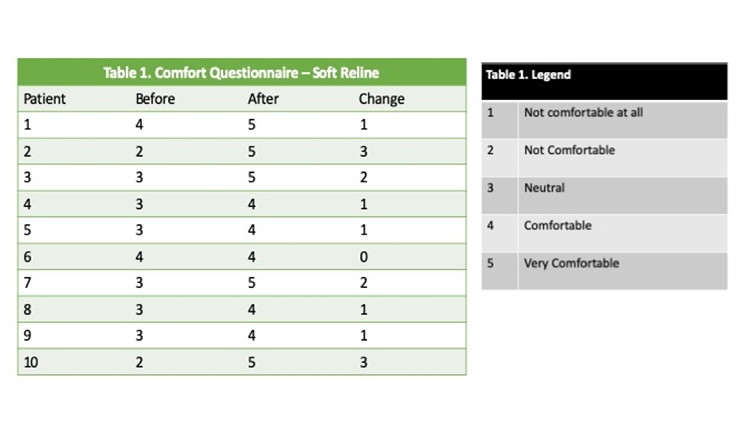
This study aimed to assess changes in patient satisfaction following a soft reline of an endosseous implant-assisted mandibular overdenture.
The 10 patients who participated had received a mandibular overdenture within a six-month period with two locators. All of the participants had two endosseous implants placed in the same approximate canine locations. The 10 patients also had their retentive male gaskets changed to the same retentive color as previously placed. A soft reline material, either Parkell’s MucoSoft or Dentsply Sirona’s PermaSoft, was placed as per its manufacturer’s instructions.
The patients were asked to fill out a comfort questionnaire twice. The first time was prior to the soft reline. The second time was one month later to report any change in their comfort and satisfaction. To assist the patients in their responses to the questionnaire, three questions were asked:
- Does the soft relined overdenture lift or move during eating and speaking?
- Is there any pain or discomfort at any time?
- What is your overall experience with the soft relined overdenture?
A Likert-type model was used to allow patients to rate changes in satisfaction. We chose this model because it allows either an increase or a decrease in satisfaction. It also allows for a range in possible intensity of feelings. To help prevent any potential bias, no examiner was present while the patients filled out the questionnaire. The results were tabulated (Table 1) and found to be statistically sound (p value = 0.0020).
When patients presented for the initial soft reline of the mandibular overdenture, the retentive male gaskets were changed to the same color as those previously placed. This was part of the experimental design to minimize variables. It also would allow the survey to be more specific by eliminating the retentive gasket as a variable and help us determine whether or not patient satisfaction improved by the addition of a soft reline material.
Discussion
Soft reline materials are classified as silicone elastomers, consisting of dimethylsiloxane polymers, with a chemical composition similar to that of the silicone impression materials. Silicon impression materials are known to retain their elastic properties. These products are auto polymerized and cured at room temperature.
Soft reline materials, when coupled with a proprietary bonding liquid, chemically graft to the acrylic (polymethyl methacrylate) denture base resin. This grafting prevents a delamination failure between the silicone reline material and the denture acrylic.
MucoSoft and Permasoft are examples of such soft reline materials. They have a lifespan of approximately one year and can extend to several years. Soft reline materials are commonly used in complete and partial removable dentures to allow for a more even distribution of masticatory loads and to increase denture retention and fit.
A soft reline material placed in a complete denture acts as a shock absorber. It also works to maintain intimate contact with underlying mucosal tissue. This soft tissue contact is compressed during function, which would lead to an increase in retention and can minimize trauma by a better distribution of masticatory load.
Better intimate soft tissue contact in the distal section of a mandibular overdenture can reduce the vertical lift of the posterior section of the denture in use. Minimizing vertical lift will help alleviate and reduce possible trauma associated with complete lower dentures, especially atrophic ridges. It will also allow a more secure fit for the patient’s overall comfort.
Conclusion
The fabrication of an endosseous implant-assisted overdenture using two locators has become the standard of care in the dental community. Our comfort survey showed that nine out of 10 participants had a change in their perceived comfort level after their mandibular overdenture was relined with a soft reline.
This study demonstrated that a soft reline can increase the comfort of the overdenture. In addition, relining of a mandibular overdenture can aid in better retention with less trauma to the mucosal tissue. In most dental offices, the retentive male gaskets are replaced approximately every 12 months.
To increase the patient’s satisfaction, the appointment to change the gaskets could be coupled with the change of soft reline material. The change of retentive gaskets and soft reline material at the same dental appointment is an economical way to maintain comfort and patient satisfaction with a mandibular overdenture.
Dr. Tregerman received his DDS degree from Columbia University in 1982. He is a full-time associate professor at the Medical University of South Carolina James B. Edwards College of Dental Medicine. He can be reached at tregerma@musc.edu.
Dr. Lane is a recent graduate of the Medical University of South Carolina James B. Edwards College of Dental Medicine.
Related Articles
Are You Prepared for the Baby Boomers?
Simplifying Implant Overdentures: Contemporary Overdenture Abutment and Attachment Systems
Don’t Undervalue the Overdenture! A Secure and Affordable Option











